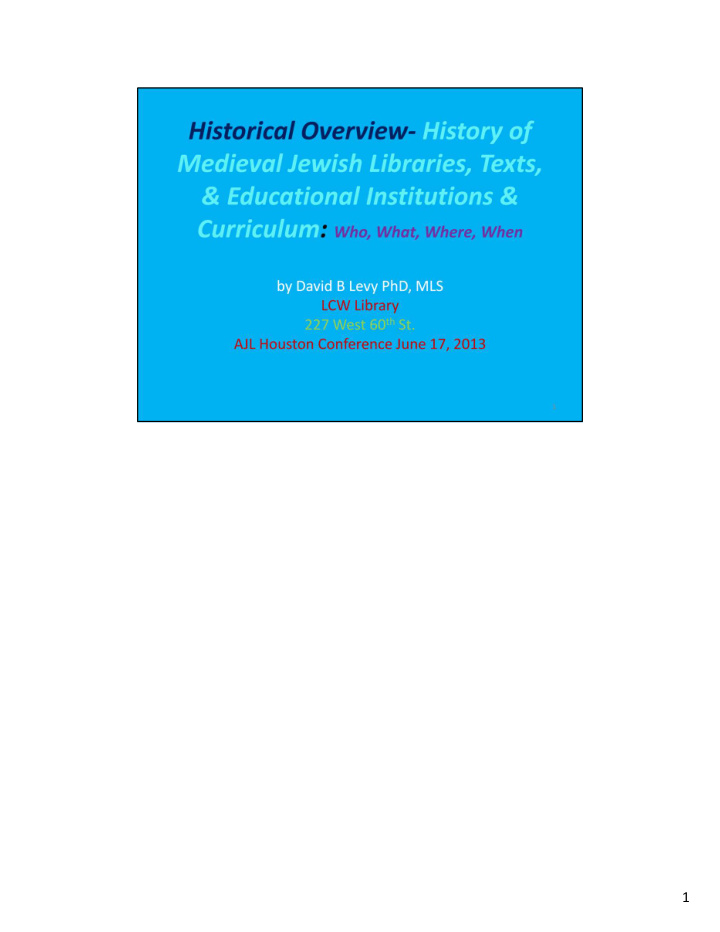



1
2
3
see: CHART 1 in ENGLISH of Periodization [time line] of Jewish History (1) Sofrim (scribes) (2) anshei Knesset HaGedolah (The Great assembly) (3) zuggot (200 BCE ‐ 70 CE) Tannaitic (70 CE to 200 CE) Amoraic (200 ‐ 500 CE) Savoraim (500 ‐ 600) Geonic (600 ‐ 900) Rishonim (900 ‐ 1450) Achronim (1450 ‐ Shoah) periods 4
5
6
Rabbis of Geonic era 7
8
9
10
11
In his pirush on Koheleth, Nahmanides declares: These issues and others like them cannot be understood properly in an essential way from one’s own reason but by means of Kabbalah which must not be written down. This issue is explained in the Torah to whomever has heard the meaning of the commandments by Kabbalah, as is proper ‐ a receiver (meqabbel) from the mouth of another receiver, going back in the chain of transmission to our master Moses who received it from the mouth of Hashem. The prohibition of writing down esoterica is further noted by Rabbi Abraham Abulafia who writes in his Sefer Shomer Mitsvah, “The Kabbalist may not reveal kabbalistic secrets, and explain them in writing, but he should disclose one handbreadth while covering two. But when the Kabbalist encoutners a person who is prepared and dedicated and worthy of having these secrets revealed to him orally (someone who is a mevin (understander), hokham (wise) and has knowledge as a knowledgable rare person (da’atan), the Informant should first reveal tow handsbreadth while covering one. And if the recipient will receive it and really desire to complete what was begun some topics may not be revealed in wriiting, in accordance with the prohibition of writiing down esoterica and oral torah in general 12
13
14
15
16
17
The Evolution of Jewish Medieval “Library Collections” and Rabbinic literature know early on as Sifrut Hazal ( זח תורפס " ל ;" Literature [of our] sages Evolved Over historical time: 18
19
20
See: CHART 3 in English of Evolution of Genres of Jewish texts 21
22
23
24
25
26
27
28
29
30
31
32
33
34
35
36
37
38
39
40
41
42
43
One can hardly realize the confusion in a genuine, old Genizah until one has seen it. It is a battlefield of books, and the literary productions of many centuries had their share in the battle, and their disjecta membra are now strewn over its area. Some of the belligerents have perished outright, and are literally ground to dust in the terrible struggle for space, whilst others, as if overtaken by a general crush, are squeezed into big, unshapely lumps, which even with the aid of chemical appliances can no longer be separated without serious damage to their constituents. In their present condition these lumps sometimes afford curiously suggestive combinations; as, for instance, when you find a piece of some rational work, in which the very existence of either angels or devils is denied, clinging for its very life to an amulet in which these same beings (mostly the latter) are bound over to be on their good behavior and not interfere with Miss Jair’s love for somebody. The development of the romance is obscured by the fact that the last lines of the amulet are mounted on some I.O.U., or lease, and this in turn is squeezed between the sheets of an old moralist, who treats all attention to money affairs with scorn and indignation. Again, all these contradictory matters cleave tightly to some sheets from a very old bible. This, indeed, ought to be the last umpire between them, but it is hardly legible without peeling off from its surface the fragments of some printed work, which clings to old nobility with all the obstinacy and obstructiveness of the Parvenu. Solomon Schechter, Description of Original State and contents of the Geniza 44
45
46
47
48
49
50
Recommend
More recommend